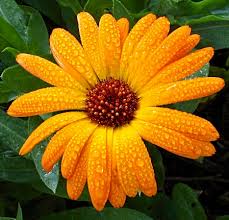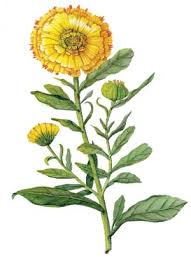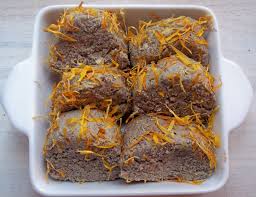* Common Names
Calendula , Pot marigold
* Botanical Name
Calendula officinalis
* Family
ASTERACEAE or COMPOSITAE Sunflower family
* Plant Description
Calendula officinalis
Flowers:
The flowers are the part used in herbal medicine. Calendula bears many
-petaled orange or yellow flowering heads two to three inches (four to seven centimeters) in diameter.
Plant type:
annual or biennial
Leaves:
The oblong green leaves help to distinquish calendula from tagetes marigolds, an unrelated species
 Flowering Season:
Flowering Season:
Begins in June. Its name refers to its tendency to bear flowers by the calendar, once a month in warm climates, usually during the new moon. "Marigold" refers to the Virgin Mary, and marigolds are traditionally used in Catholic celebrations concerning the Virgin Mary.
Distribution:
Native to the Mediterranean, grown widely as a garden flower, culitivated for use in herbal medicine.
Regional Traditions :
Calendula , Pot marigold
* Botanical Name
Calendula officinalis
* Family
ASTERACEAE or COMPOSITAE Sunflower family
* Plant Description
Calendula officinalis
Flowers:
The flowers are the part used in herbal medicine. Calendula bears many
-petaled orange or yellow flowering heads two to three inches (four to seven centimeters) in diameter.
Plant type:
annual or biennial
Leaves:
The oblong green leaves help to distinquish calendula from tagetes marigolds, an unrelated species
Begins in June. Its name refers to its tendency to bear flowers by the calendar, once a month in warm climates, usually during the new moon. "Marigold" refers to the Virgin Mary, and marigolds are traditionally used in Catholic celebrations concerning the Virgin Mary.
Distribution:
Native to the Mediterranean, grown widely as a garden flower, culitivated for use in herbal medicine.
Regional Traditions :
European
* How to Grow Calendula
Calendula is easy to grow and deserves a place in your flower, vegetable, and/or herb garden. Sow seeds directly when the soil temp reaches about 60 degrees in the spring. You will be rewarded with masses of bright green foliage and sunny, yellow blooms. Harvest the flowers when they are newly opened. Pluck the petals from the dried flower heads and store in dark-colored glass jars to preserve the medicinal properties.
* History and Traditions & Folklore
Calendula was attributed many fantastic virtues by the older herbalists. The salve, preferably cooked in goats lard, was used for burns, bruises and sunburns like it is today. (Minus the goats) During the American Civil War, calendula petals were used to staunch wounds. Marigolds are called after the Virgin Mary. In Macer's Herbal it is stated that only to look on Marigolds will draw evil humours out and strengthen the eyesight. Calendula, called "Marygold" or "sunbride" in the Middle Ages, was sacred to the Norse goddess Freya and was used for love magic.
* Common Uses:
Abrasions/Cuts - Acne - Culinary - Eye care - Vision - Insect Bites/Rashes
 * Properties:
* Properties:
Analgesic- Anti-inflammatory- Antibacterial- Antifungal- Antiscrofulous- Astringent- Cancer- Cholagogue- Depurative- Diaphoretic- Emmenagogue- Febrifuge- Vulnerary
* Parts Used:
flowers and oil
* Constituents:
carotenoids, resin, essential oil, flavonoids, sterol, bitter principle, saponins, mucilage
* See Also:
Chamomile Flower -Dandelion Root -Elecampane -Immortelle Oil -Safflower Oil
* Calendula Uses & Benefits : Natural Skin Care
Calendual Skin Care The deep orange and yellow flowers of Calendula officinalis hold the medicinal properties that make Calendula one of the most loved flowers in herbal skin care. Calendula petals yield a fixed oil that is beneficial for many types of skin problems, and mild enough to use in almost any situation.Home Remedies for First Aid Calendula oils, creams and salves make it a particularly good treatment for cuts, scrapes, bruises, and minor wounds. It is an excellent idea to keep calendula treatments handy for Dr. Mom's first aid kit.
* Other great benefits of calendula :
Calendual flowers are anti-bacterial and a tea infusion of the fresh petals is useful as an eyewash for conjunctivitis (pink eye). Calendula tinctures and teas can also calm stomach upsets, reducing inflammation and yeast overgrowths that can be root causes of food allergies, gastritis and and irritable bowel problems
* Calendula How to Use
Calendua Flower - for : Wasp or Bee stings
Marigold (calendula) rubbed on the affected part, is an admirable remedy for the pain and swelling of the sting of wasp or bee.
* How to Grow Calendula
Calendula is easy to grow and deserves a place in your flower, vegetable, and/or herb garden. Sow seeds directly when the soil temp reaches about 60 degrees in the spring. You will be rewarded with masses of bright green foliage and sunny, yellow blooms. Harvest the flowers when they are newly opened. Pluck the petals from the dried flower heads and store in dark-colored glass jars to preserve the medicinal properties.
* History and Traditions & Folklore
Calendula was attributed many fantastic virtues by the older herbalists. The salve, preferably cooked in goats lard, was used for burns, bruises and sunburns like it is today. (Minus the goats) During the American Civil War, calendula petals were used to staunch wounds. Marigolds are called after the Virgin Mary. In Macer's Herbal it is stated that only to look on Marigolds will draw evil humours out and strengthen the eyesight. Calendula, called "Marygold" or "sunbride" in the Middle Ages, was sacred to the Norse goddess Freya and was used for love magic.
* Common Uses:
Abrasions/Cuts - Acne - Culinary - Eye care - Vision - Insect Bites/Rashes
Analgesic- Anti-inflammatory- Antibacterial- Antifungal- Antiscrofulous- Astringent- Cancer- Cholagogue- Depurative- Diaphoretic- Emmenagogue- Febrifuge- Vulnerary
* Parts Used:
flowers and oil
* Constituents:
carotenoids, resin, essential oil, flavonoids, sterol, bitter principle, saponins, mucilage
* See Also:
Chamomile Flower -Dandelion Root -Elecampane -Immortelle Oil -Safflower Oil
* Calendula Uses & Benefits : Natural Skin Care
Calendual Skin Care The deep orange and yellow flowers of Calendula officinalis hold the medicinal properties that make Calendula one of the most loved flowers in herbal skin care. Calendula petals yield a fixed oil that is beneficial for many types of skin problems, and mild enough to use in almost any situation.Home Remedies for First Aid Calendula oils, creams and salves make it a particularly good treatment for cuts, scrapes, bruises, and minor wounds. It is an excellent idea to keep calendula treatments handy for Dr. Mom's first aid kit.
* Other great benefits of calendula :
Calendual flowers are anti-bacterial and a tea infusion of the fresh petals is useful as an eyewash for conjunctivitis (pink eye). Calendula tinctures and teas can also calm stomach upsets, reducing inflammation and yeast overgrowths that can be root causes of food allergies, gastritis and and irritable bowel problems
* Calendula How to Use
Calendua Flower - for : Wasp or Bee stings
Marigold (calendula) rubbed on the affected part, is an admirable remedy for the pain and swelling of the sting of wasp or bee.
Calendua flower lotion - for : Sprains, abrasions
A lotion made from the flowers is most useful for sprains and wounds, and a water distilled from them is good for inflamed and sore eyes.
Calendula Cream - for : Acne, antibacterial
Calendula's orange petals are antibacterial and anti-inflammatory, properties that can relieve acne.
Calendula oil - for : Heal skin, stop bleeding
Anti-inflammatory, astringent, and antiseptic, calendula promotes new skin growth and inhibits bleeding.
Calendula tea - for : Thrush, conjunctivitis
A compress is useful to treat varicose veins and chilblains, while a cold infusion may be used as an eyewash for conjunctivitis. Marigolds are also antifungal and so can help to cure thrush (Candida albicans)
Calendula tea - for : Conjunctivitis,Fevers - Fevers
A lotion made from the flowers is most useful for sprains and wounds, and a water distilled from them is good for inflamed and sore eyes.
Calendula Cream - for : Acne, antibacterial
Calendula's orange petals are antibacterial and anti-inflammatory, properties that can relieve acne.
Calendula oil - for : Heal skin, stop bleeding
Anti-inflammatory, astringent, and antiseptic, calendula promotes new skin growth and inhibits bleeding.
Calendula tea - for : Thrush, conjunctivitis
A compress is useful to treat varicose veins and chilblains, while a cold infusion may be used as an eyewash for conjunctivitis. Marigolds are also antifungal and so can help to cure thrush (Candida albicans)
Calendula tea - for : Conjunctivitis,Fevers - Fevers
An infusion of calendula flower petals has been used to for treating conjunctivitis and other eye infections. A tea made from fresh blossoms can be taken to break a fever by inducing perspiration.
Calendula tincture - for : Gums
+ Fairytale Tea
A delicious drink for children and adults. A delightful and inspiring infusion blend full of flowers & fairy magic; perfect for bedtime stories. All organic.
Calendula flowers, Red Clover flowers Lavender flowers,Chamomile flowers,Lemon Balm, Catnip, Spearmint, Skullcap, Thyme, Oatstraw,Lemon peel and a pinch of Stevia.
+ Calendula Flowers
Calendula officinalis Origin- USA Biodynamic Certified
+ Restorative Skin Oil
Previously known as Secret Skin Oil this is currently the much revered formula for dry and mature skin.
Contains:
+ Aches & Pains Massage Oil
A deeply penetrating and soothing herbal oil for aches and pains, and relief from fatigue and stiffness, with just the right ingredients to add a slightly euphoric aroma.Organic Calendula flowers infused with organic Olive oil, organic Jojoba oil, organic Sweet Almond oil, Vitamin E oil, and a blend of pure essential oils.
Calendula tincture - for : Gums
Calendula benefits gums with its antiviral, anti-inflammatory, and immune-stimulating compounds. Typical Dosage: apply tincture to the affected area up to three times daily
 * In the Kitchen:
* In the Kitchen:
The bright calendula florets give color and nutritional value to soups and salads. Dried calendula blossoms are also an economical substitute for saffron to color rice. Pull petals off before using in dishes, do not eat calyx or flower centers.
* How to Use: Calendula
Preparation Methods & Dosage :
Calendula can be taken as an herbal tea, used as a tincture, and applied as a poultice. Calendula oil is used as a base for salves and ointments. Combines well with comfrey and St. John's wort for skin healing.
* Remedies using : Calendula
+ Quick Tips
A lotion made from one cup of fresh calendula blossoms simmered in two cups of milk is an excellent wash for the complexion. For a sore throat or indigestion, drink calendula tea or use it to gargle, for scrapes and bruises apply the tea directly to your skin
+ Calendula extract
(Calendula officinalis) Extracted from: Fresh flower Ratio: 1:2
+ Calendula Herbal Oil
Gentle, cooling, and soothing. Calendula oil is the most successful oil for assisting us with dry and damaged skin, skin inflammations, rashes, diaper irritations, and other skin disorders.
The bright calendula florets give color and nutritional value to soups and salads. Dried calendula blossoms are also an economical substitute for saffron to color rice. Pull petals off before using in dishes, do not eat calyx or flower centers.
* How to Use: Calendula
Preparation Methods & Dosage :
Calendula can be taken as an herbal tea, used as a tincture, and applied as a poultice. Calendula oil is used as a base for salves and ointments. Combines well with comfrey and St. John's wort for skin healing.
* Remedies using : Calendula
+ Quick Tips
A lotion made from one cup of fresh calendula blossoms simmered in two cups of milk is an excellent wash for the complexion. For a sore throat or indigestion, drink calendula tea or use it to gargle, for scrapes and bruises apply the tea directly to your skin
+ Calendula extract
(Calendula officinalis) Extracted from: Fresh flower Ratio: 1:2
+ Calendula Herbal Oil
Gentle, cooling, and soothing. Calendula oil is the most successful oil for assisting us with dry and damaged skin, skin inflammations, rashes, diaper irritations, and other skin disorders.
Contains:
Certified organic Calendula flowers (Calendula officinalis), infused in certified organic Olive Oil and a pinch of Vitamin E oil.
+ Fairytale Tea
A delicious drink for children and adults. A delightful and inspiring infusion blend full of flowers & fairy magic; perfect for bedtime stories. All organic.
Calendula flowers, Red Clover flowers Lavender flowers,Chamomile flowers,Lemon Balm, Catnip, Spearmint, Skullcap, Thyme, Oatstraw,Lemon peel and a pinch of Stevia.
+ Calendula Flowers
Calendula officinalis Origin- USA Biodynamic Certified
+ Restorative Skin Oil
Previously known as Secret Skin Oil this is currently the much revered formula for dry and mature skin.
Contains:
Organic Calendula oil, organic Rosehip seed oil, Vitamin E, and a blend of pure essential oils including Neroli and Helichrysum.
+ Aches & Pains Massage Oil
A deeply penetrating and soothing herbal oil for aches and pains, and relief from fatigue and stiffness, with just the right ingredients to add a slightly euphoric aroma.Organic Calendula flowers infused with organic Olive oil, organic Jojoba oil, organic Sweet Almond oil, Vitamin E oil, and a blend of pure essential oils.



Really informative blog which looks very attractive and thanks for giving out the usage of all the herbs which are very helpful for the Herbal Remedies.
ReplyDeleteWell i like to have unique type of information joint diseases, herbal medicines and for this i search different type of plants to get new type of species. Thanks for the great medium of useful stuff. Keep sharing like that.
ReplyDeleteI like your all posts.
ReplyDeleteIt's very helpful.
Thanks! for sharing.
Liver support herbal products
Very informative, keep posting such good articles, it really helps to know about things.
ReplyDelete